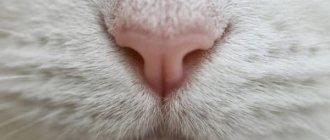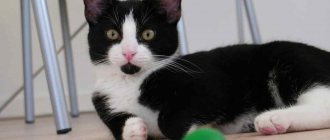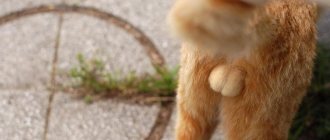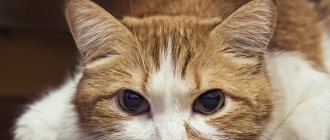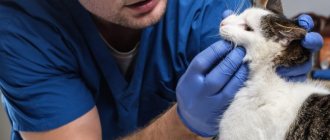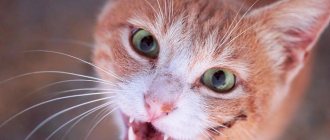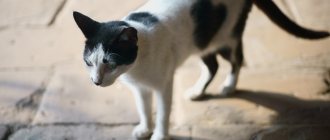A cat's nosebleeds may indicate temporary disruption of the integrity of blood vessels, and in some cases it is a serious symptom of a dangerous disease.
The intensity of nosebleeds varies - the faster the blood is released, the greater the danger looming over the pet.
In most cases, bleeding from the nasal cavity in cats occurs as a result of injuries to small vessels due to mechanical damage to the mucous membrane or during inflammatory processes. The mucous membrane lining the nasal cavity has a large number of small vessels and nerve endings.
Given the great mobility and curiosity of cats, nasal injuries are not that uncommon. If your pet experiences even one nosebleed, it is strongly recommended to visit a veterinarian. This will allow timely detection of possible pathology and avoid complications.
Causes of bleeding and degree of danger
Bleeding is caused by many different factors. The most common reasons: injuries, infectious diseases, the presence of parasites, dental problems, unstable functioning of the circulatory system, heat stroke, poisoning, etc.
The exact source can only be determined by a specialist.
If blood appears due to injury, there is a risk of inflammation. Often it affects the entire respiratory system and gives rise to new diseases. When bleeding is observed from both nostrils, this is a clear sign of clotting problems.
A young pet—especially a kitten—is at serious risk under these circumstances. If you do not contact a veterinarian in time, the situation can get much worse. In particularly advanced cases, death is possible.
Help an animal
Treatment for bleeding depends on the test result. If an animal is diagnosed with an infectious disease, a course of antibiotics is prescribed; for fungal infections, fungicidal drugs are prescribed.
If you have high blood pressure (hypertension), appropriate medications are prescribed to lower it.
Complex injuries, deformation of the nasal passages, and neoplasms are treated only surgically. A deeply stuck foreign object is removed with surgical instruments using anesthesia.
In case of poisoning with rat poison or hemophilia, vitamin K is indicated. Vasoconstrictor drugs and Adrenaline are injected into the nasal cavity.
For nosebleeds, symptomatic treatment and the use of drugs that promote blood clotting are indicated.
Traditional methods
If parasites are the cause of your pet's nosebleeds, they need to be removed. A decoction of tansy helps against fleas. It is used to rinse the animal's fur after bathing. In other cases, folk remedies are powerless.
At home, stop bleeding by applying cold to the back of the cat's nose. It is impossible to treat a pathology without knowing the cause. Wrong actions of the owner can cause the development of irreversible consequences.
The animal needs specialist consultation, a complete and comprehensive examination, and complex therapy.
The relationship between bleeding and periodontal disease
It is common to experience bleeding due to dental disease. This is explained by the fact that the upper jaw bone of a cat is quite thin, and the roots of the fangs are located at great depths. Therefore, if inflammatory processes are present in them, their products can enter the nasopharynx. In this case, the disease also affects the blood vessels. This causes bleeding.
Diagnostics
In order to find out why a cat’s nose is bleeding, the veterinarian prescribes a comprehensive examination of the animal.
Diagnostic methods:
- Tests are performed: general or biochemical blood test, coagulation test, endoscopy, biopsy, cytology, x-ray examination of the nasal cavity;
- A careful visual examination, examination of the nasal as well as oral tracts, mouth, lower nostrils, throat.
- Urinalysis to assess liver function;
- Serological tests are carried out for the presence of fungal diseases, as well as infections caused by ticks;
- Carrying out computed tomography, magnetic resonance imaging;
- Rhinoscopy;
- Blood pressure measurement;
- Surgery for residual diagnosis.
The need for a specific diagnostic method is determined by the veterinarian depending on the complexity of the symptoms. After the diagnosis is established, treatment is prescribed to eliminate the bleeding, as well as the reasons that caused it.
Mr. Cat warns: associated symptoms
Signs indicating that the animal urgently needs to be taken to the veterinarian:
- Sneezing is accompanied by bleeding.
- Periodontal disease or gumboil occurs.
- An unpleasant odor appears from the oral cavity.
- There are breathing problems.
- Lost appetite.
You should also pay attention to where exactly the blood is coming from. In some cases, it may not be the nostrils, but a wound caused by a broken tooth. Such damage occurs in the event of severe injuries such as falls or being hit by a car.
The fact that the problem is long-standing and advanced is also indicated by the animal swallowing blood.
Photo
The cat's nose is bleeding.
Blood on the nose.
Traces of blood in the nose.
Broken nose.
Severe inflammation.
Diagnosis and first aid
To determine the cause of the disease, the veterinarian must subject the cat to a series of tests. First of all, blood and urine tests are taken. The nasal and oral cavities are examined in detail, and x-rays of these areas may be prescribed. In some cases, a smear will be required to look for infection and parasites.
If your pet is bleeding, you need to remain calm and not irritate the animal, so as not to provoke a rise in blood pressure.
A cold compress applied to the nose can stop the bleeding at first, but in any case, do not hesitate to visit the veterinarian.
Cat nosebleeds
Nosebleeds can be a sign of serious illness, including injury, and are caused by droplets of blood when you sneeze or a persistent drip or stream of blood from one or both nostrils. What to do if you suspect or discover a nosebleed in your pet?
First Aid Let's say you're at home and your cat has started bleeding and won't stop.
- Try to calm the animal. When cats are excited, just like people, their blood pressure increases, which increases bleeding. Do not give your animal any sedatives without consulting your veterinarian.
- Ask family members to remain quiet and calm, as nervous excitement is transmitted from owners to animals. Again, let us recall the chain: excitement - increased blood pressure - nosebleeds.
- Place an ice pack on the bridge of your cat's nose. Make sure this does not obstruct breathing. Cold causes blood vessels to constrict, which reduces bleeding.
- If after taking the measures the bleeding does not stop or the animal has problems breathing, immediately contact a veterinary clinic or call an ambulance.
While waiting for the doctor or on the way to the clinic, be calm, concentrate and remember some details that will be of great importance for making a diagnosis.
- Make a list of medications you currently give to your cat.
- Is there rat poison in your house or apartment, or perhaps your cat might have eaten poisoned rodents?
- Carefully examine the animal's face. You may find asymmetry or deformation, swelling of the bridge of the nose, changes in the integrity or color of the skin on the bridge of the nose, a protruding and reddened third eyelid, unequal size of the eyeballs, and lacrimation. Bring this to the doctor's attention.
- Has your cat played excessively active games with another animal? Did she go for a walk without your supervision? Maybe there was a fight?
- Has there been contact with plants that have hard awns? For example, such as wheat or rye.
- Does the animal sneeze? Does he rub his nose with his paws?
- Open the animal's mouth as wide as possible, inspect the gums and lips. Is there blood in the mouth? Do you notice dryness and marbled coloration of the mucous membranes of the oral cavity and conjunctiva? This may indicate a large loss of blood, and urgent hospitalization may be required. Please draw the attention of the clinic reception staff to this; the doctor must accept such a patient without waiting in line .
- Are there signs of bleeding from internal organs? Intestinal bleeding may be accompanied by black, soiled stool. A sign of stomach bleeding is vomiting blood. Attention! If these signs appear after a nosebleed, it may be due to a nosebleed as the cat has swallowed a significant amount of blood.
- Are there any hemorrhages on the skin, swelling on the body (there may be subcutaneous bleeding)?
This information must be passed on to the doctor during the examination. To make a diagnosis, in addition to a general clinical examination, the following diagnostic tests may be required.
Blood and urine tests Clinical blood tests (with a mandatory platelet count) and urine are necessary to assess the general state of health and the degree of blood loss, and a biochemical blood test to assess the functioning of internal organs. As a rule, a study of the blood coagulation system is carried out (the blood coagulation rate and coagulogram are assessed). Detected deviations from the norm may indicate a blood clotting disorder:
- by reducing the number of platelets in the blood (for example, with autoimmune thrombocytopenia, feline viral leukemia, feline viral immunodeficiency, side effects of certain chemotherapy drugs, hemangiosarcoma and other tumors)
- due to pathological changes in the blood coagulation system (for example, in case of hemolytic poisoning, disseminated intravascular coagulation syndrome, liver failure, von Willebrand disease and true hemophilia).
If laboratory test results are normal, then the problem probably lies in the nasal cavity itself. But before examining the nasal passages you should:
- exclude conditions accompanied by pulmonary hemorrhage - lung tumor, pulmonary edema, injury to lung tissue. To do this, an X-ray examination of the chest .
- exclude arterial hypertension, since when blood pressure increases, small capillaries of the nasal mucosa rupture, which leads to bleeding. To do this, the cat's blood pressure is measured.
If everything is fine with the lungs, they proceed to X-ray examination of the nose, superficial rhinoscopy and examination of the teeth , all these procedures require general anesthesia. They start with x-rays, since other methods can injure tissue. Radiography allows you to assess the condition of the roots of the teeth and sinuses. In the case of a nasal tumor, an area of bone destruction may be visible on an x-ray. During superficial rhinoscopy, the nasal cavity is examined and foreign objects that cause bleeding are removed from it. When examining the oral cavity, teeth are cleaned, paying special attention to the roots, since a tooth root abscess often affects the nasal sinus cavity.
What next If standard research methods fail to make a diagnosis, a deep endoscopic examination of the nasal passages is performed. During the study, a tissue biopsy is taken, but only if indicated, as there is a risk of increased bleeding. Additionally, for some reasons it may be difficult to obtain an informative tissue sample:
- the growth of nasal tumors is often accompanied by severe inflammation, which masks the oncological process
- in conditions of bleeding, it is difficult to select a tissue site for puncture.
Detection of a tumor of the facial part of the skull as a result of an X-ray examination is an absolute indication for a biopsy, since the prognosis of the disease largely depends on the type of tumor.
And in conclusion , it must be said that sometimes bleeding areas can only be examined surgically. This procedure is the most traumatic and is accompanied by severe bleeding, so it is used only in exceptional cases to remove a hard-to-reach foreign object or take a tissue sample.
Treatment and prevention
Frequent bleeding is treated with compresses and medications that increase blood clotting. It is possible to use sedatives, as well as drugs aimed at combating the cause of the disease.
In order not to expose the animal to the risk of bleeding, you need to carefully monitor its condition, protect it from injury and get vaccinations on time.
With proper care, the possibility of disease is significantly reduced.
If the cat is injured and bleeding comes from the nose, after first aid you should immediately go to the veterinary clinic. Timely treatment and observation by a specialist will help save the furry patient from new injuries and complications.
1111
How to treat a cat
First of all, the pet needs to stop the bleeding so that the animal does not suffer from excessive loss. Sedative medications may also be useful to calm your cat. In panic, he may cause himself even greater harm.
If the pet is calm or you can restrain it (a good way is to bandage the whole body up to the neck with a blanket), then you need to put an ice compress or a cold towel on its nose. This will help narrow the damaged capillaries. Let's use this method to treat minor injuries. Drops are usually not used.
The doctor may also use adrenaline, which stops the bleeding. In the most advanced situations, the veterinarian uses anesthesia to examine the nasal cavity. The cat, severely injured, begins to run quickly, interfering with the inspection.
Treatment of the problem depends on the causative agent. If the cause is an infection, then the pet is prescribed antibiotics and other antiviral medications. It is possible to prescribe surgery, but before surgery the animal must undergo chemotherapy. When the cause is an oral disease, the pet will have to be operated on. The same is true with tumors. If the doctor does not detect any pathologies, then a cold compress is applied to the face and a vasoconstrictor is administered.
© shutterstock
If you do not want your pet to have a nose bleed, then you need to regularly bring him to the veterinary clinic for vaccination against contagious infections . You also need to feed the animal nutritious food containing vitamins and essential microelements. The veterinarian should be visited not only in critical situations, but also for prevention. It is recommended to visit once every couple of months. He will notice in time that your pet is sick.
Features during treatment
Many owners have a question: how can periodontal disease cause nosebleeds in a cat? There is a connection between periodontal disease and bleeding due to the structure of the tooth. The root of a cat's tooth is very long. When periodontal disease begins, the decay products of the infection reach the alveoli. There are a lot of blood vessels in this area that are affected by the virus. Damaged vessels begin to bleed, resulting in fluid flowing out of the nose.
The reason may be completely harmless and harmless. One of them is thermal shock affecting the capillaries. They burst, causing bleeding. All this happens because cats are very sensitive to changes in high and low temperatures.
